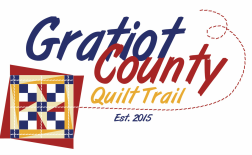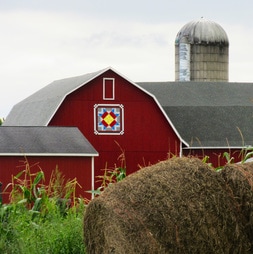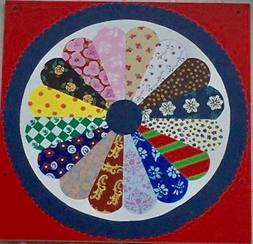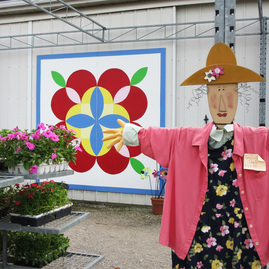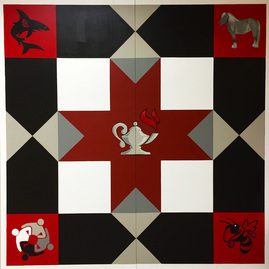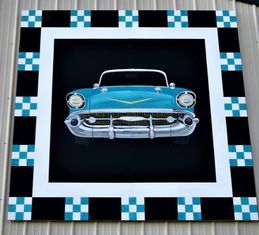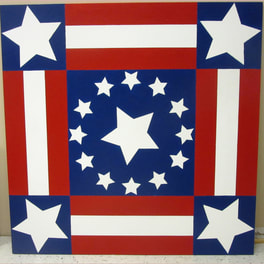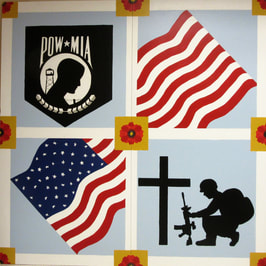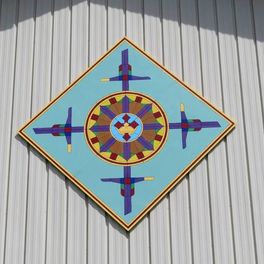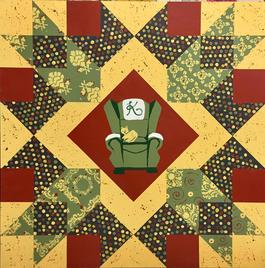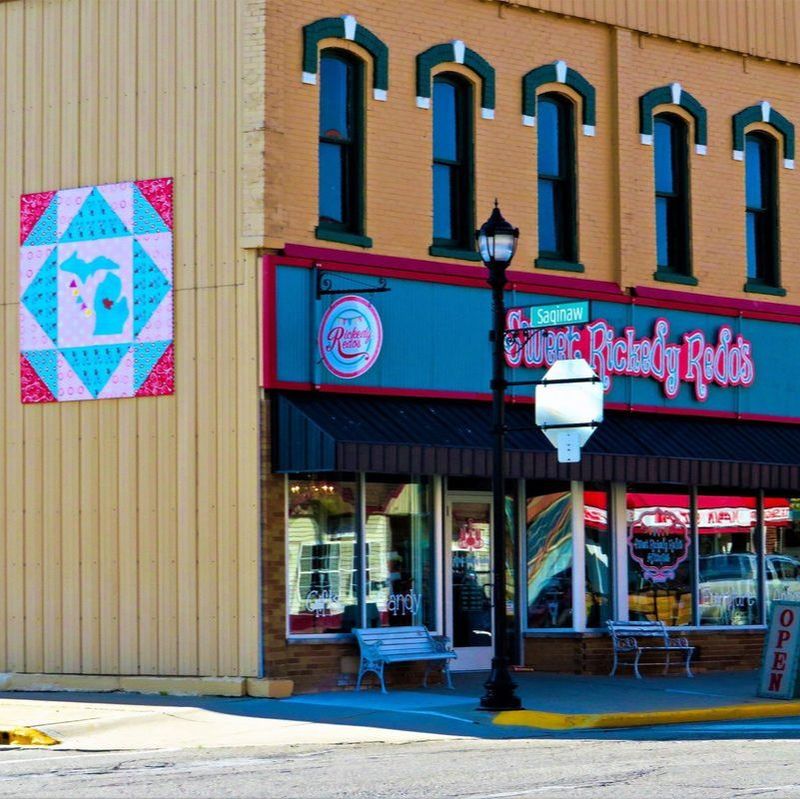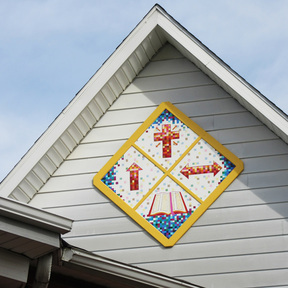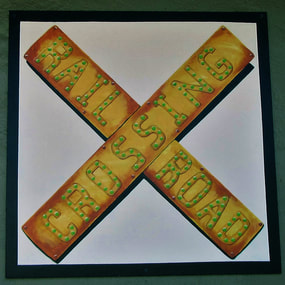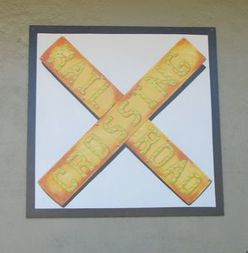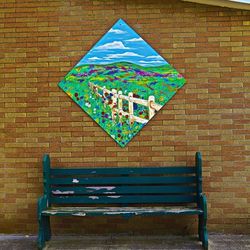|
16. McCune Family Farm - St. Louis
William and Lucy Gibbs came from Vermont and settled on the 40 acres which they purchased from Stephen Parks for $700.00. The farm was originally swamp which had to be cleared and drained by oxen. William cut some of the lumber from the 60 acres of virgin timber surrounding the farm and built the existing barn and home (original house no longer on property, new home built in 1975). The barn was built in 1917 and is still one of the biggest and well kept barns in the community. The name on the barn is Elmwood which was chosen for all the Dutch Elm that were on the property. The Gibbs family also owned and operated the General Store in Pleasant Valley located a quarter mile south of the farm. In 1905, William's daughter, Carrie, married Charles McCune. During WWI and WWII, Charles used horses to do the general farming. He farmed 120 acres with three horses. The first tractor purchased was a steel wheeled F-12 IHC in 1938. In November 1943, Grenville (known to family as Richard or Dick) married Frances I. McClintic. They farmed and had a dairy operation. On July 24, 1976 Chas W. (Chuck) married Cathy L. (Loomis) McCune and they have lived and farmed the land since then, purchasing the farm in 1988 and continuing a dairy operation with their son, Chase. Chuck and Cathy's family consists of their daughter, Katie L. Eisenberger (her husband, Jesse, sons Gunner and Gauge, and daughter Mae Katherine), their son, Chase W. McCune (his wife Tracie L. (Becker) McCune, and daughters, Emma L. , Ava J. and Charli R.). The farm now consists of over 500 acres including rental property. The Centennial Block was chosen to represent the farm family's over 100-year history. The block was chosen in memory of Frances, who was a hard working farm woman and mother, and to my grandmother, Agnes (Recker) Loomis, who covered her large farm family of 11 children along with their spouses and children with gifts of homemade quilts and rugs during her lifetime. The McCunes have a commitment to their cows, land, and community. Each year the family hosts the Cowabunga Classic, a fundraiser to help cancer patients in Gratiot/Isabella Counties. This is a way the family gives back to the community, while also giving neighbors an opportunity to learn about dairy farming by visiting the farm. The McCunes are proud of their farm and enjoy visitors. The second quilt block, Gramma Shorty's Dresden Plate is beautifully revised from the original quilt still hanging on display indoors. |
|
17. Country Meadows Farm - St. Louis
The Apple Blossom Quilt Block signifies new growth each spring. Country Meadows is a new greenhouse operation, and there are plants in every stage of the growing process throughout the year. It is also the Michigan state flower and shows the owners' love of flowers and the great State of Michigan. Vibrant primary colors were chosen to help illustrate the many different flowers in bloom every day. |
|
18. Wing Family - St. Louis
The St. Louis Star Quilt Block graces a beautiful country setting and represents the owners; love of their community and educational teaching background. 19. Pat's Auto, Inc. - St. Louis
The '57 Chevy is a favorite of this family business offering quality service to Gratiot County. |
|
20. Pine River Township Hall - St. Louis
The Patriot Star Quilt Block represents local government at its finest as it represents an entire community. 21. St. Louis VFW Post 3055 - St. Louis
The St. Louis VFW was founded in November 1970 and was named after Fred E. Richard, who was killed in Vietnam. The Quilt Square honors our nation’s veterans with a Four Square Patriotic Poppy design. |
|
22. St. Louis Church of Christ - St. Louis
The Cross and Crown block signifies Heaven's timeless message to humankind. 23. Kubin's Quality Furniture - St. Louis
The Comfy Chair Block represents high-quality furniture, mattresses, and accessories in a spectacularly restored historic building. It is a St. Louis landmark. |
|
24. Common Threads Quilt Shop - St. Louis
The Spool Quilt Block is showcased in the window of the only quilt shop in Gratiot County. 25. City of St. Louis - St. Louis
This site marks the location of the famous Magnetic Mineral Springs discovered in 1869. Hundreds of invalids came to St. Louis by stagecoach and train to bathe in and drink the healing waters. These visitors included Civil War generals and a sitting Chief Justice of the U.S. Supreme Court. Pictured at upper left is the Spring House where the celebrated waters flowed free to all on the bank of the Pine River. A replica of this building is located on the grounds of the Cutler Memorial Library in St. Louis. At upper right is the bath house where thousands of medicinal baths were given. Its balcony jutted over the bank of the Pine River giving guests a lovely view. At lower left is the famed Park Hotel, built in front of the bath house facing Mill Street and later known far and wide for its delicious duckling dinners. At lower right is the present St. Louis City Hall, which was opened in 2015 and was built on the frame of the former IGA grocery store. All of these buildings have occupied this historic site. The colors, shades of blue, green and brown, reflect the colors of the original buildings and scenery based upon on-site water-color paintings done many years ago. |
|
26. Sweet Rickedy Redos - St. Louis
The Heart of the Mitten represents a beautiful stores filled with unique, fund, whimsical gifts and an old-fashioned candy counter. You'll love it! 27. First Baptist Church - St. Louis
The Connect 4 block was designed to represent the mission of First Baptist Church in St. Louis: to connect the disconnected to a growing relationship with Jesus Christ. Each image is a symbol that communicates how that mission is accomplished: the Bible represents God’s Word as a foundation and the others represent the commitment of the Church to connect people to God, to each other, and others to Christ. First Baptist Church was established in 1856 by a group of St. Louis residents who desired to worship together and bring their children up in the Christian faith. The building on which this block is mounted was originally built in 1872. The quilt square is affixed to one of the many additions to the original building. The First Baptist Church believes it is important to be connected to the community and is honored to be included on the Gratiot County Quilt Trail. |
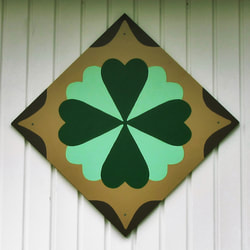
28. Larsen Home - St. Louis
The Four-Leafed Shamrock square represents Kathy Larsen’s Irish heritage and the pride of her family’s ancestry. The shamrock was used as the universal symbol to represent Ireland. It is portrayed with four leaves to represent good luck. Steve Larsen often recalled hours of searching his parents’ lawn for a four-leaf clover as a child. The beige background with a dark brown border makes the image stand out and compliments the house design. Despite not having a barn to hang the square on, the couple has always longed for the country life due to their history of helping out on the farm and taking part in outdoor recreational activities. The Larsens feel the quilt square brings a little bit of country to their urban dwelling, which they have inhabited for 46 years.
The Four-Leafed Shamrock square represents Kathy Larsen’s Irish heritage and the pride of her family’s ancestry. The shamrock was used as the universal symbol to represent Ireland. It is portrayed with four leaves to represent good luck. Steve Larsen often recalled hours of searching his parents’ lawn for a four-leaf clover as a child. The beige background with a dark brown border makes the image stand out and compliments the house design. Despite not having a barn to hang the square on, the couple has always longed for the country life due to their history of helping out on the farm and taking part in outdoor recreational activities. The Larsens feel the quilt square brings a little bit of country to their urban dwelling, which they have inhabited for 46 years.
|
29. St. Louis Historical Society - St. Louis
The Railroad Crossing Block is located at the Pere Marquette train depot on Crawford Street between Main and Franklin Streets in St. Louis. First built in the late 1880s, this wooden depot burned in 1922. People speculated that the fire was a blessing in disguise, as a new depot would be much better than the old one. In August 1922 a contract was let to Spence Brothers of Saginaw to build a new depot. To avoid another fire, the new 21 by 64-foot building had masonry walls. Extended canopies sheltered passengers leaving and boarding coaches. At one time six daily passenger trains—three each way—stopped in St. Louis. The last passenger train left the depot in 1942. For the next 20 years the depot was used as a freight office and storage area, then it was abandoned for several years. In 1999 the St. Louis Historical Society acquired the depot and has turned it into a beautiful museum preserving St. Louis history. The site also includes a 1917 Republic Truck, restored log cabin and the original “toll booth” that was on the old Plank Road at the entrance to St. Louis. 30. Linton Family - St. Louis
The Wildflower Block represents that owner's love of wild flowers. |
